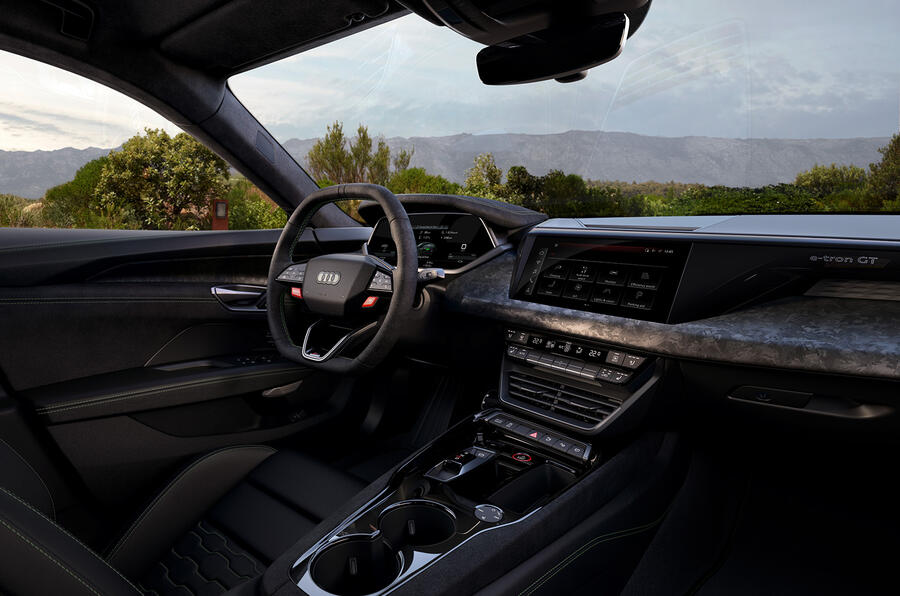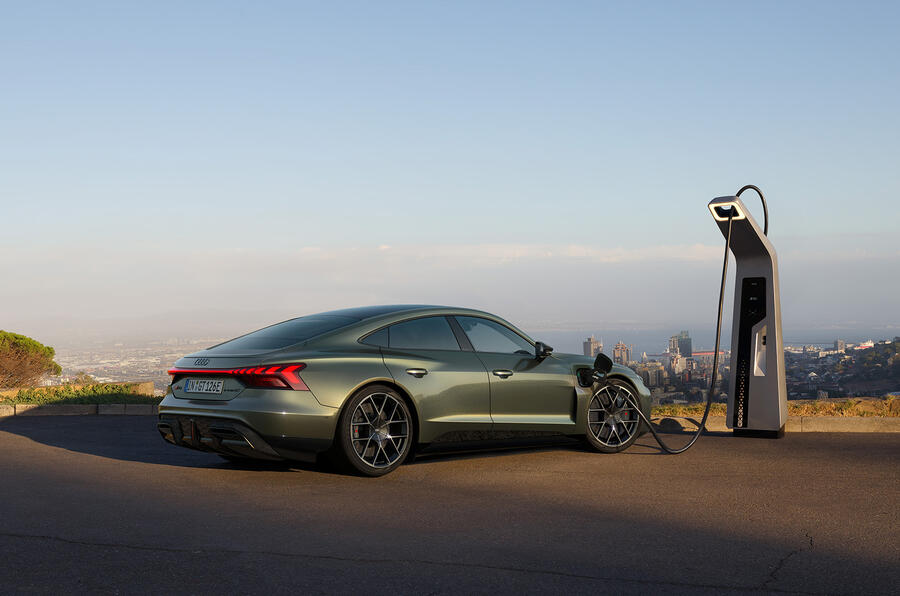Recent Updates
07/10/2024 12:00 PM
Audi Q8 E-tron could be axed early as firm mulls factory closure
07/10/2024 12:00 PM
Skoda Kodiaq review
07/10/2024 12:00 PM
Mercedes-AMG C63 S E Performance
07/10/2024 12:00 AM
Porsche 911
07/10/2024 12:00 AM
Ariel Nomad 2: sub-700kg brawler gets Focus ST power
07/09/2024 12:00 PM
The new Audi e-tron GT: 6 big changes (and why they matter)
07/09/2024 12:00 PM
M25 closure set to impact Goodwood Festival of Speed
07/09/2024 12:00 PM
Alfa Romeo Junior
07/09/2024 12:00 AM
The longest-range electric cars you can buy today
07/09/2024 12:00 AM
Lexus slashes up to £7100 off EV and hybrid line-up
EV, Hybrid, Hydrogen, Solar & more 21st century mobility!
 We explore under the skin of Audi’s new-look four-door all-electric coupé to find out why it’s even more thrilling to drive
We explore under the skin of Audi’s new-look four-door all-electric coupé to find out why it’s even more thrilling to drive
How do you define progress? It’s a word embedded deep in Audi’s DNA, with the brand’s ‘Vorsprung durch Technik’ ethos of ‘progress through technology’ underpinning every major design evolution and engineering innovation over the last 50-plus years. And that’s especially true now Audi has gone electric.
When it was first revealed in late 2020, the Audi e-tron GT challenged and changed perceptions of what an electric car could look like and how exciting electric driving could be, thanks to its sleek head-turning four-door coupe style, it’s headline-grabbing performance and range, and its thrilling all-electric quattro handling.Â
Well, now it’s time for the Audi e-tron GT’s next evolutionary step.Â
Adding even more desirable style across a more distinctive three-strong line-up – which starts with the Audi S e-tron GT, adds extra spice with the Audi RS e-tron GT, and goes full-out with the Audi RS e-tron GT performance – the new Audi e-tron GT has been designed and engineered to take the already amped-up performance and quattro driving character of Audi’s all-electric range-topper to the next level.
So, let’s break down the six biggest changes that mark just how far the new Audi e-tron GT has progressed. And it all starts with performance.
Learn more about Audi e-tron and the new Audi e-tron GT

#1: Up to 925PS of all-electric quattro power
Like its predecessor, the new Audi e-tron GT uses advanced permanent magnet synchronous motors on the front and rear axle for true quattro all-wheel-drive. But, as you’d expect for a next-generation model, Audi’s engineers have given them some added spark for this new Audi e-tron GT.
As a result, the new Audi S e-tron GT delivers a combined output of 592PS in normal driving, and up to 679PS and 740Nm of torque under launch control conditions. That’s more power than the outgoing Audi RS e-tron GT. The new Audi RS e-tron GT takes that enhanced electric performance to the next level, boasting 680PS in normal driving and a combined output of 857PS and 865Nm of torque under launch control conditions.
But here comes the big one. Thanks to modified power electronics and a revised pulse inverter on the front axle motor, allied to a new more-potent rear-axle motor that’s 10kg lighter – thanks to a redesigned rotor and stator and enhanced cooling – the range-topping Audi RS e-tron GT performance offers 748PS in normal driving and up to an astonishing 925PS and 1072Nm of torque under launch control conditions, making it the most powerful production car Audi has ever built: electric or otherwise.

#2: A ‘boost’ button for thrilling accelerationÂ
Using the control satellite function on the new-look race-inspired steering wheel of the Audi RS e-tron GT and Audi RS e-tron GT performance, you can access a new ‘boost’ function, which delivers a 10-second burst of 94PS when driving. There’s even a cool little countdown in the cockpit, letting you know just how much boost you’ve got left at your disposal.
#3: Up to 375 miles of range*
Thanks to a wealth of technical improvements, enhanced materials and innovations in thermal management and cooling technology, Audi’s engineers have reduced the weight of the Audi e-tron GT’s battery pack by 9kg, while simultaneously improving its energy density to 105kWh gross capacity (97kWh net).Â
Equally, the Audi e-tron GT’s regenerative braking capacity has been enhanced from 290kW to 400kW, meaning it recaptures even more energy during deceleration. The combined result of that is an all-electric range of up to 375 miles (WLTP)*.

#4: Up to 320kW ultra-rapid charging**
Audi’s engineers have further optimised the new Audi e-tron GT’s 800V electric architecture and thermal management systems, increasing its potential charging speeds to 320kW**. The operating window for ultra-rapid charging has also been widened, enabling high charging performance in temperatures as low as 15C.
As a result, the Audi e-tron GT’s battery can be recharged from 10% to 80% in as little as 18 minutes on a compatible ultra-rapid charger or can add as many as 174 miles in as little as 10 minutes**. And the number and availability of ultra-rapid chargers where you can do that is growing fast.Â
Whichever charging network you use, the new Audi e-tron GT helps you find the right chargers to fit your journey by delivering more in-depth information about your potential charging performance through the Virtual Cockpit – including the battery’s temperature, its pre-conditioning status, and a predicted quick-charging forecast. Working with the Audi e-tron GT’s smart electric-focused in-car satellite navigation, that means you can find the right chargers to top-up fast and keep moving.

#5: Advanced active suspension for a smoother ride
The new Audi e-tron GT has a newly developed two-chamber two-valve air suspension as standard, which further enhances the model’s celebrated blend of dynamic engaging handling and sublime long-range refinement and comfort.
On the new Audi e-tron GT you can also pick a new and highly innovative active suspension. In addition to smoothing out and neutralising bumps in the road, it’s designed to actively counter mid-corner body roll, as well as minimising how the car squats longitudinally under acceleration and dives onto its nose under braking.
By keeping the body of the new Audi e-tron GT as close to horizontal and level as possible while cornering, it delivers more highly precise steering, increased control and more balanced grip across the car during dynamic driving.
The Audi RS e-tron GT and the Audi RS e-tron GT performance add the option of RS-specific modes, while the Audi RS e-tron GT performance has an exclusive mode optimised for track driving on challenging race circuits.Â
The Audi RS e-tron GT’s active suspension also includes a cool comfort entry feature, which can raise the car’s height by up to 77 millimetres when the vehicle is stood still, making it even easier for you to get in and out.

#6: All-wheel steering for confident cornering
Last, but certainly not least, there’s the new Audi e-tron GT’s optional all-wheel steering system. It can rotate the rear wheels by up to 2.8 degrees to offer enhanced stability on a twisty road or enhanced manoeuvrability around town.Â
At speeds over 50mph, the rear wheels turn by up to 2.8 degrees in the same direction as the front wheels, working with the Audi e-tron GT’s all-electric quattro all-wheel drive to enhance mid-corner stability.Â
At speeds below 50mph, the all-wheel drive system turns the wheels in the opposite direction to the front wheels. Working with the new Audi e-tron GT’s more direct front-axle steering ratio, that reduces steering effort at lower speeds and narrows the car’s turning radius by about 0.6 metres for low-speed manoeuvres around town.
So, those are all the reasons why the new Audi e-tron GT is taking electric performance, range and driving character to the next level. Maybe it’s time to try it for yourself.
Learn more about Audi e-tron and the new Audi e-tron GT
* Range dependent on trim and optional equipment. All vehicles are tested according to WLTP technical procedures. Figures shown are official test values for comparability purposes; only compare fuel consumption, CO2 and electric range figures with other vehicles tested to the same technical procedures. These figures may not reflect real life driving results, which will depend upon a number of factors including but not limited to factory fitted options, accessories fitted (post-registration), variations in weather, road and traffic conditions, individual driving styles, vehicle load, vehicle condition, use of systems like climate control (and, for battery electric vehicles, the starting charge, age and conditions of the battery). Figures for battery electric vehicles were obtained after the battery had been fully charged. Battery electric vehicles require mains electricity for charging. Zero emissions while driving. Figures quoted are subject to change due to ongoing approvals/changes and figures may include options not available in the UK.
** Timings based on a 10 to 80% charge using an ultra-rapid DC public charge station at the vehicle’s maximum charging capability. Ultra rapid charging stations are still limited in the UK, with numbers planned to increase. Actual charging times will vary depending on various factors, including the selected vehicle (and battery option, if available), the type of charger used, the level of charge in the battery, the age type, condition and temperature of the charger and the battery, the power supply, ambient temperature at the point of use and other environmental factors.Â
